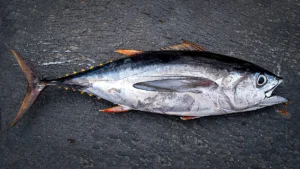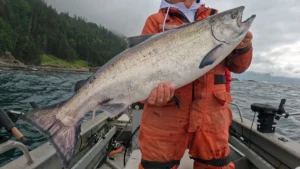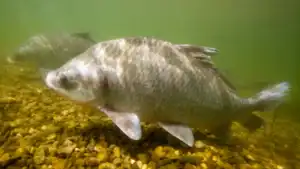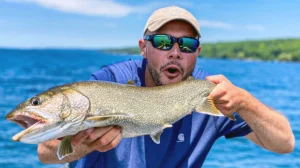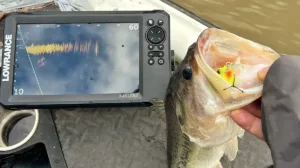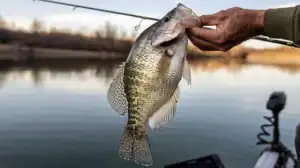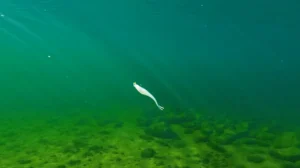Smallmouth bass (Micropterus dolomieu) are pound-for-pound one of the hardest-fighting sportfish in North America, but did you know scientists have found there are actually three genetic lineages of smallmouth within the U.S.? If this is news to you, get ready to learn all about smallmouth in the Wired2fish complete guide to smallmouth bass.
SMALLMOUTH BASS HISTORY
Smallmouth bass belong to the sunfish family (Centrarchidae), which also includes bluegill sunfish, spotted bass, crappie and largemouth bass.
The scientific name of smallmouth bass is Micropterus dolomieu and the story for how it got that name began in 1802 with Bernard Germain de Lacépède. Lacépède a French naturalist, wrote and published the “Natural History of Fish” included in the first edition of the book was the first description of the smallmouth bass and the entire black bass family. The story goes that Lacépède received a package containing a preserved specimen that appeared to have three dorsal fins. The first being spiny, followed by a larger softer dorsal fin, and then another smaller one. The third dorsal fin was actually due to a tear in the second dorsal fin, which led to the misleading naming of Micropterus which translates to small or short-fin. Lacépède also wanted to honor a deceased friend, Déodat Dolomieu, by naming a species after him. Therefore, we got the scientific name Micropterus dolomieu.
Three distinct genetic lineages of smallmouth bass have been identified. The northern smallmouth bass is the most widespread and officially carries the name Micropterus dolomieu dolomieu, there is the Neosho smallmouth bass Micropterus dolomieu velox, and the Ouachita smallmouth bass that has an unofficial name of Micropterus sp. Cf. dolomieu velox. The northern smallmouth and Neosho smallmouth bass identification and differences were officially defined in 1940.
Alternative names for smallmouth bass
The smallmouth bass has several nicknames, including brown bass, brown trout, smallie, bareback, brownie, bronze bass and bronze back bass.
SMALLMOUTH BASS IDENTIFICATION
Smallmouth bass have a torpedo- or oval-shaped body that allows them to move quickly through moving water. Their backs have brownish green to gold coloration that lightens down their sides to a yellow to white stomach. The sides have eight to sixteen darker vertical bands or bars with some scattered small dark spots. The coloration and markings of a smallmouth bass can change due to its environment. In clear water, the color will be darker with more contrasting markings and in turbid water, the markings will become duller and hard to identify. Three dark stripes extend from the snout down the cheek to throughout the operculum.
The dorsal fins have 9-10 hard spines followed by 16-15 rays, the connection between the spiny and soft dorsal fin being continuous and shallow notched. Scales can be found at the base of the soft dorsal and anal fins. The anal fin has three spines. A critical factor in helping identify a smallmouth bass is to look at the upper jaw; it does not extend beyond the eye when the mouth is closed. The northern smallmouth’s mouth extend to the middle of the eye and the overall mouth is the smallest of all Micropterus species.
The Neosho smallmouth will have a more slender and elongated body. The body stripes will be shorter and thinner compared to the northern smallmouth. The operculum will have a dark spot, the upper jaw extends to the back edge of the eye when the mouth is closed, and the lower jaw extends beyond the snout when the mouth is closed. The Oachita smallmouth bass will appear similar to Neosho with a more modeled spotting on its sides and spots on the soft dorsal and anal fins.
SMALLMOUTH BASS LOCATION
Smallmouth bass are native to cooler freshwater bodies of water in eastern and central North America. Native populations are considered to have been initially throughout the St. Lawrence River and the Great Lakes system. Their southern boundary crept into Tennessee, parts of Mississippi and as far west as Oklahoma. Today we know the further southern outreaching areas of Oklahoma and Arkansas are home to Ouachita smallmouth bass while those found in the Ozarks region are the Neosho smallmouth bass.
The expansion of smallmouth bass, specifically northern smallmouth, throughout the United States began in the 1800s and today they can be found throughout the lower 48 states. They continue to spread northward deeper into Canada and have been attempted in at least 25 additional countries. Populations can be found in Austria, Belgium, Belize, Czechia, Japan, Mexico, Slovakia, South Africa, and Vietnam. Smallmouth have even been introduced and are thriving in Hawaii. Several European countries had experimental and unintentional introductions that were unsuccessful.
It’s important to note that in many areas outside of the US consider smallmouth bass an exotic invasive species that prey on native fishes and alter food webs. Even at home in the US smallmouth bass have caused genetic issues by hybridizing with species such as Guadalupe bass, a black bass species with a limited home range. Within the smallmouth bass family the Neosho and Ouachita genetic lineage have shrinking ranges due to the widespread stocking and hybridization with northern smallmouth bass.
To see the historic home ranges and today’s distribution of smallmouth bass, we have developed the interactive map below.
SMALLMOUTH BASS SPAWNING
Smallmouth bass spawning generally occurs when the water temperature reaches 60ºF, although in some rivers and streams this could be at water temperatures as low as 55ºF if water temperatures rarely exceed 75ºF.
Spawning begins with males moving into littoral zone areas of the waterbody. The littoral zone is defined as the depth where sunlight can penetrate to the bottom sediment and it is controlled primarily by water clarity. In streams and rivers smallmouth will also move to slow moving water areas to escape current for spawning.
During spawning males may develop red eye coloration and females may become darker in coloration. Males mature at 2 to 4 years of age while females mature at 3 to 4 years. The largest males and females will spawn earlier then the rest of the population.
Males create nests by sweeping their caudal fin along the bottom sediment to remove silt and expose gravel and hard substrate. The resulting nest will be a shallow depression with a saucer shape. Their preferred spawning site will be near rock or hardwood structure and within 70 to 150 feet of their previous year’s nest. Smallmouth bass have defined home ranges and may require short migrations to return to their spawning site.
Females will move to the nesting area and be courted by male fish. The spawning process lasts for several hours with multiple egg fertilization attempts. Each actual spawning act lasts just 5-10 seconds with continual courtship.
Females can lay between 2,000-16,000 eggs per nest and carry up to 27,000 eggs. The smallmouth bass eggs are larger than other black bass species at .07 to .1 inch. The eggs are fairly transparent with a white to yellow coloration and adhesive. Over time the eggs harden and become less adhesive.
Males provide paternal care constantly using their fins to oxygenate the eggs and remove sediment. Females will move onto another nesting site to continue to spawn immediately. Eggs hatch in 2 to 10 days depending on water temperature, with warming water allowing fry to hatch more quickly. Fry hatch at .15 to 1/4-inch in size. Initially upon hatching they are unable to swim and over 4 to 16 days depending on water temperature they absorb their yolk sack, develop pigment and begin to swim. Fry smallmouth continue to develop and appear adult like at around 1 inch in length. They remain in large tight schools gradually foraging alone during daytime and reentering schools overnight.
Males have extremely dedicated paternal care resulting often in high nesting success, however their constant care leaves them vulnerable to exhaustion, predation and angling. Once a male is removed from a nest it may not return or can experience higher mortality rates. Because of this nesting smallmouth are often protected by fisheries managers to allow for successful rearing.
SMALLMOUTH BASS SIZE AND LIFESPAN
Smallmouth bass growth rates are highly dependent on forage availability, water temperature and geographic location. Typically smallmouth will grow faster in lakes and reservoirs compared to rivers and streams. They will also grow faster in warmer climates. Males will have slightly quicker growth to mature size averaging a year faster than females. Once maturation occurs there is little sexual dimorphism between males and females.
Although many factors determine growth rates, first and second year growth can range from 3 1/2 to 6 inches per year. Growth rates in year 3 can range from 2 to 4 inches and subsequent years can be 1 inch of growth per year. On average, it can take 3 years to reach 10 inches and over 7 years to be 16 inches. Forage can strongly manipulate growth rates; recent studies suggest an increase in growth among goby-fed smallmouth of up to 15% compared to historic growth rates before goby introductions.
Cooler water environments allow smallmouth bass to reach advanced age. On average, smallmouth bass live 6 to 12 years with a maximum lifespan of 15 years in the majority of the U.S.. At the northern reaches of their current distribution, you can find fish over 20 years old in Canada, with the oldest-recorded fish being 26 years old.
The biggest smallmouth ever caught is the world record smallmouth caught on Dale Hollow Lake in 1955 and weighed 11 pounds, 15 ounces.
SMALLMOUTH BASS DIET
Smallmouth bass are known for their aggressive nature and extremely hard-fighting ability when hooked by an angler. They are carnivores consuming insects, crawfish and fishes using both directly hunting and ambushing prey. Smallmouth bass have a fairly large mouth gap, although smaller than other black bass species. They consume forage using whole body consumption like other bass species.
They are visual predators, relying on sight with both auditory and olfactory senses being used as secondary locating techniques. Their olfactory senses are used to a great extent compared to other black bass species. Due to this turbidity can slightly limit foraging distance but does not appear to alter success once forage is located.
In the early stages of life as soon as smallmouth bass develop mouth parts they will consume copepods, water fleas and other zooplankton. At 2 inches in length, smallmouth will begin consuming insects, other juvenile fish and larger zooplankton.
At 4 inches they transition into feeding on primarily crawfish, fishes and insects. Diet studies continually provide evidence that smallmouth bass consume crawfish at a rate higher than any other forage item. Crawfish can make up 60-to 90-percent of total forage consumption. The exception to the crawfish dominated diet appears to be the presence of gobies.
Once gobies are introduced and become abundant smallmouth bass will transition to a 50- to 60-percent goby diet with a 5- to 10-percent crawfish consumption. Naturally smallmouth found in rivers and streams tend to have a higher ratio of insects and benthic crustaceans in their diets compared to their lake or reservoir counterparts.
Also, read our coverage on the best lures to catch smallmouth bass with.
SMALLMOUTH BASS HABITAT
Smallmouth bass can be considered habitat generalists that can adapt to both river and lake systems. They have well-defined home ranges that increase in size in the spring and fall. During summer and winter months, smallmouth home ranges shrink and the fish school more tightly together. Home ranges are so ingrained that smallmouth can travel back to their capture site more easily than other black bass species following angler transportation and release.
Smallmouth prefer clearer water but can inhabit turbid water at times. They select areas with rock, timber and topographic features. They will utilize submerged aquatic vegetation edges and sparse growth but generally prefer to not be within dense growth.
Adults will migrate moving to littoral zone areas of the fishery for spawning and quickly back to their home range following the spawning season. Young-of-the-year smallmouth bass generally stay within the littoral zone they were born in until winter when they move offshore.
SMALLMOUTH BASS FISHING
Fishing for smallmouth bass is an absolute blast. They are aggressive and rambunctious and offer a ton of fight for their size. The will fall for topwaters, spinnerbaits, finesse baits like drop shots, ned rigs, tubes, jigs and more. Most of the best bass lures will fool a smallmouth in certain situations. But that handful we mentioned are often the main players.
SMALLMOUTH BASS THREATS
Smallmouth bass are slightly vulnerable to nest loss or abandonment, their parental behavior leaves the nest vulnerable as males are the only protection for eggs and fry. Once caught, they have a tendency to abandon their nest or even die due to a lack of feeding during the spawning season. Protective spawning areas and seasons have been widely successful to limit nest loss due to anglers catching and removing male smallmouth bass.
Smallmouth bass will hybridize with many other black bass species causing genetic dilution. Many species of black bass can and will hybridize with smallmouth resulting in a cross that is often referred to as a “Meanmouth”. This can occur with largemouth bass, although it’s rare. More common is a cross with a spotted bass or Alabama bass. The introduction and hybridization with Alabama bass does have a long-term effect that certainly reduces the genetic purity of smallmouth bass in specific fisheries. Numerous fisheries have had their entire smallmouth population diluted due to this process.
The Neosho and Ouachita smallmouth are also extremely susceptible to hybridization. Both species have seen reduced home range size due to hybridization with northern smallmouth bass. This process does work both ways with other species such as Guadulupe bass being vulnerable to increased smallmouth bass introductions and hybridizations as well.
Recently, smallmouth bass have been found to be infected with Largemouth Bass Virus (LMBV) Santee-Cooper ranavirus, Family Iridoviridae. In 2018 the LMBV virus was found to be a cause of young of the year smallmouth death in summer months within the Susquehanna River Basin. Additional positive fish were found shortly after in the Juniata and Allegheny rivers. In 2021 additional studies found LMBV in smallmouth throughout Michigan.
LMBV positive fish have also been found to have lesions on sides that have secondary bacterial infections of both Aeromonas and Flavobacterium columnare. The lesions are the primary external clinical sign of the virus, additionally LMBV positive fish may have protruding eyes, enlarged internal organs and before death, extreme lethargy. Unfortunately due to the tight-schooling nature of smallmouth bass the LMBV can spread quickly during summer and winter months. The extent of adult mortality is still being studies, but mass juvenile mortality has been confirmed.
SMALLMOUTH BASS FACTS YOU NEED TO KNOW
- The smallmouth bass are considered to have the second-largest maximum size of all black bass species.
- The IGFA world record is 11 pounds, 15 ounces from Lake Dale Hollow in 1995 by angler David Hayes.
- IGFA length record is 53 cm or 20.87 inches and is held by WIlliam Brent Evans (Guntersville, Ala. in 2014) and Shane Hoelzle (Osoyoos Lake, Wash. in 2020).
- Meanmouth bass are smallmouth bass hybridized with either largemouth, spotted or Alabama bass.
- IGFA currently recognizes a smallmouth/Alabama bass cross with a weight of 6 pounds, 5 ounces caught by Joel Ross at Pickwick Lake, Tenn. in 2020 as the record for that specific cross.
- IGFA currently recognizes a smallmouth/largemouth bass cross with a weight of 11 pounds, 1 ounce caught by Brady Stanford on O.H. Ivie Reservoir, Texas in 2022 as the record for that specific cross.
- Smallmouth are more closely related to spotted bass than largemouth bass.
- The oldest smallmouth bass known is 26 years old.
- Smallmouth bass are one of two state fish for Tennessee, with the other being channel catfish.
ABOUT THE AUTHOR
Steven Bardin obtained his bachelor’s degree in Freshwater Biology from Tarleton State University in 2009 and his master’s degree in Fisheries Science from Texas A&M in 2013. While at Tarleton, Bardin worked for Harrell Arms at Arms Fish Farm and Bait Company. In 2011 he founded Texas Pro Lake Management. He strives every day to take a scientific approach to helping his clients maximize the production of their fisheries.
Outside of TPLM Bardin has written for Wired2fish, taught as an adjunct professor for Tarleton State University, and served as an instructor and camp coordinator for Bass Brigade youth leadership camp. In 2021, Bardin helped Major League Fishing found their Fisheries Management Division and leads their conservation efforts today.
Bardin is a member of Texas Aquatic Plant Management Society, Texas Chapter of American Fisheries Society, Southern Division of American Fisheries Society, Society of Lake Management Professionals, Texas Freshwater Fishing Hall of Fame Board, Texas Brigades Board, Texas Freshwater Fisheries Advisory Committee, and the Major League Fishing Anglers Association Board.







